With an area of 2,289 sq km, it is indented by the Saronic Gulf (southeast) and the Gulf of Corinth (northwest), which are linked via a navigable canal through the Isthmus of Corinth. Ephyra (Watchtower), is the ancient name of the plateau of Corinth, which has been inhabited since the Neolithic Period. 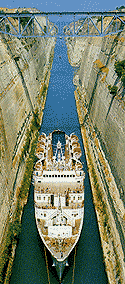 The ruins of ancient Corinth are spread out at the foot of the huge rock of Acrocorinth. The monuments are mainly of Roman; only a few are Greek. One can trace the Long Walls which began at the sum-mit of Acrocorinth and descended all the way to Lechaion , the artificial harbour ïn the Corinthian Gulf. Lechaion was the start of Lechaion road which led to the ancient agora. This was paved with flagstones and lined with sidewalks, arcades and shops. The area of the marketplace was filled with imposing buildings, temples and business emporia.
The ruins of ancient Corinth are spread out at the foot of the huge rock of Acrocorinth. The monuments are mainly of Roman; only a few are Greek. One can trace the Long Walls which began at the sum-mit of Acrocorinth and descended all the way to Lechaion , the artificial harbour ïn the Corinthian Gulf. Lechaion was the start of Lechaion road which led to the ancient agora. This was paved with flagstones and lined with sidewalks, arcades and shops. The area of the marketplace was filled with imposing buildings, temples and business emporia.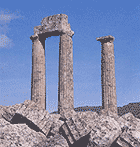 The Doric temple of Apollo (6th c. BC with 1st . AD restorations) stands in a knoll to the north of the agora it is the most important monument of that period. On the northwest of the agora lie the ruins of the 4th century BC theatre-which underwent some changes in the Roman era and the Roman Odeon. The museum is in the southwest sector of the site. It contains mosaic floors, Mycenaean and Corinthian pottery, terra cotta sphinxes, statues of two super-natural beings, relief plaques, the Roman head of the Goddess Tyche and small objects of various kinds. On the north side of the building one can see the remains of the fountain of Glauke hewn out of the rock. Glauke, daughter of King Creon, was the reason why Jason deserted Medea. In revenge Medea sent her as a wedding gift a poisoned mantle which envelopped the girl in flames the moment she put it in. In order to save herself she leapt into the fountain which since then has born her name. Acrocorinth The imposing mass of Acrocorinth (Akrokorinthos) rises out of the ground at the edge of the ancient city. At the top of the pinnacle, at an altitude of 575 metres, a stood the acropolis of Corinth during ancient and medieval times. This is the largest and oldest fortress the plateau narrows toward Xilocastro and terminates into a forest.
The Doric temple of Apollo (6th c. BC with 1st . AD restorations) stands in a knoll to the north of the agora it is the most important monument of that period. On the northwest of the agora lie the ruins of the 4th century BC theatre-which underwent some changes in the Roman era and the Roman Odeon. The museum is in the southwest sector of the site. It contains mosaic floors, Mycenaean and Corinthian pottery, terra cotta sphinxes, statues of two super-natural beings, relief plaques, the Roman head of the Goddess Tyche and small objects of various kinds. On the north side of the building one can see the remains of the fountain of Glauke hewn out of the rock. Glauke, daughter of King Creon, was the reason why Jason deserted Medea. In revenge Medea sent her as a wedding gift a poisoned mantle which envelopped the girl in flames the moment she put it in. In order to save herself she leapt into the fountain which since then has born her name. Acrocorinth The imposing mass of Acrocorinth (Akrokorinthos) rises out of the ground at the edge of the ancient city. At the top of the pinnacle, at an altitude of 575 metres, a stood the acropolis of Corinth during ancient and medieval times. This is the largest and oldest fortress the plateau narrows toward Xilocastro and terminates into a forest.
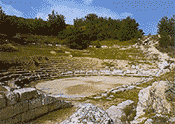 Mount Killini in the central western part of the department is the highest peak, at 2,376 m, in the Peloponnese peninsula. Several navigable rivers with deep, straight valleys empty northward into the Gulf of Corinth. Some wheat, barley, citrus fruits, olives, and grapes are cultivated along the coasts. Dairy farming, vegetable growing, and raising of sheep and goats also number among the agricultural activities of the department. Forestry and food processing are the main industries. Recreational hunting (duck shooting) is done at the Stymphalian lake in the southwest. The main town is Corinth, the administrative centre of tehenoms, located at the northeastern corner of the Peloponnese near the Isthmus. Acrocorinth, the ancient acropolis of Corinth, has buildings of the Christian, Turkish, and Venetian periods. To Corinth's south, the terraced hills produce small, dark currants and seedless sultanas for raisins. Loutraki is a seaside resort on the shores of the Gulf of Corinth. Nemea, home of the ancient Nemean Games, is celebrated for its red wine. The main highway runs between Athens (east) and Patrai (west) along the north shore of the Gulf of Corinth.
Mount Killini in the central western part of the department is the highest peak, at 2,376 m, in the Peloponnese peninsula. Several navigable rivers with deep, straight valleys empty northward into the Gulf of Corinth. Some wheat, barley, citrus fruits, olives, and grapes are cultivated along the coasts. Dairy farming, vegetable growing, and raising of sheep and goats also number among the agricultural activities of the department. Forestry and food processing are the main industries. Recreational hunting (duck shooting) is done at the Stymphalian lake in the southwest. The main town is Corinth, the administrative centre of tehenoms, located at the northeastern corner of the Peloponnese near the Isthmus. Acrocorinth, the ancient acropolis of Corinth, has buildings of the Christian, Turkish, and Venetian periods. To Corinth's south, the terraced hills produce small, dark currants and seedless sultanas for raisins. Loutraki is a seaside resort on the shores of the Gulf of Corinth. Nemea, home of the ancient Nemean Games, is celebrated for its red wine. The main highway runs between Athens (east) and Patrai (west) along the north shore of the Gulf of Corinth.
 The ruins of ancient Corinth are spread out at the foot of the huge rock of Acrocorinth. The monuments are mainly of Roman; only a few are Greek. One can trace the Long Walls which began at the sum-mit of Acrocorinth and descended all the way to Lechaion , the artificial harbour ïn the Corinthian Gulf. Lechaion was the start of Lechaion road which led to the ancient agora. This was paved with flagstones and lined with sidewalks, arcades and shops. The area of the marketplace was filled with imposing buildings, temples and business emporia.
The ruins of ancient Corinth are spread out at the foot of the huge rock of Acrocorinth. The monuments are mainly of Roman; only a few are Greek. One can trace the Long Walls which began at the sum-mit of Acrocorinth and descended all the way to Lechaion , the artificial harbour ïn the Corinthian Gulf. Lechaion was the start of Lechaion road which led to the ancient agora. This was paved with flagstones and lined with sidewalks, arcades and shops. The area of the marketplace was filled with imposing buildings, temples and business emporia. The Doric temple of Apollo (6th c. BC with 1st . AD restorations) stands in a knoll to the north of the agora it is the most important monument of that period. On the northwest of the agora lie the ruins of the 4th century BC theatre-which underwent some changes in the Roman era and the Roman Odeon. The museum is in the southwest sector of the site. It contains mosaic floors, Mycenaean and Corinthian pottery, terra cotta sphinxes, statues of two super-natural beings, relief plaques, the Roman head of the Goddess Tyche and small objects of various kinds. On the north side of the building one can see the remains of the fountain of Glauke hewn out of the rock. Glauke, daughter of King Creon, was the reason why Jason deserted Medea. In revenge Medea sent her as a wedding gift a poisoned mantle which envelopped the girl in flames the moment she put it in. In order to save herself she leapt into the fountain which since then has born her name. Acrocorinth The imposing mass of Acrocorinth (Akrokorinthos) rises out of the ground at the edge of the ancient city. At the top of the pinnacle, at an altitude of 575 metres, a stood the acropolis of Corinth during ancient and medieval times. This is the largest and oldest fortress the plateau narrows toward Xilocastro and terminates into a forest.
The Doric temple of Apollo (6th c. BC with 1st . AD restorations) stands in a knoll to the north of the agora it is the most important monument of that period. On the northwest of the agora lie the ruins of the 4th century BC theatre-which underwent some changes in the Roman era and the Roman Odeon. The museum is in the southwest sector of the site. It contains mosaic floors, Mycenaean and Corinthian pottery, terra cotta sphinxes, statues of two super-natural beings, relief plaques, the Roman head of the Goddess Tyche and small objects of various kinds. On the north side of the building one can see the remains of the fountain of Glauke hewn out of the rock. Glauke, daughter of King Creon, was the reason why Jason deserted Medea. In revenge Medea sent her as a wedding gift a poisoned mantle which envelopped the girl in flames the moment she put it in. In order to save herself she leapt into the fountain which since then has born her name. Acrocorinth The imposing mass of Acrocorinth (Akrokorinthos) rises out of the ground at the edge of the ancient city. At the top of the pinnacle, at an altitude of 575 metres, a stood the acropolis of Corinth during ancient and medieval times. This is the largest and oldest fortress the plateau narrows toward Xilocastro and terminates into a forest. Mount Killini in the central western part of the department is the highest peak, at 2,376 m, in the Peloponnese peninsula. Several navigable rivers with deep, straight valleys empty northward into the Gulf of Corinth. Some wheat, barley, citrus fruits, olives, and grapes are cultivated along the coasts. Dairy farming, vegetable growing, and raising of sheep and goats also number among the agricultural activities of the department. Forestry and food processing are the main industries. Recreational hunting (duck shooting) is done at the Stymphalian lake in the southwest. The main town is Corinth, the administrative centre of tehenoms, located at the northeastern corner of the Peloponnese near the Isthmus. Acrocorinth, the ancient acropolis of Corinth, has buildings of the Christian, Turkish, and Venetian periods. To Corinth's south, the terraced hills produce small, dark currants and seedless sultanas for raisins. Loutraki is a seaside resort on the shores of the Gulf of Corinth. Nemea, home of the ancient Nemean Games, is celebrated for its red wine. The main highway runs between Athens (east) and Patrai (west) along the north shore of the Gulf of Corinth.
Mount Killini in the central western part of the department is the highest peak, at 2,376 m, in the Peloponnese peninsula. Several navigable rivers with deep, straight valleys empty northward into the Gulf of Corinth. Some wheat, barley, citrus fruits, olives, and grapes are cultivated along the coasts. Dairy farming, vegetable growing, and raising of sheep and goats also number among the agricultural activities of the department. Forestry and food processing are the main industries. Recreational hunting (duck shooting) is done at the Stymphalian lake in the southwest. The main town is Corinth, the administrative centre of tehenoms, located at the northeastern corner of the Peloponnese near the Isthmus. Acrocorinth, the ancient acropolis of Corinth, has buildings of the Christian, Turkish, and Venetian periods. To Corinth's south, the terraced hills produce small, dark currants and seedless sultanas for raisins. Loutraki is a seaside resort on the shores of the Gulf of Corinth. Nemea, home of the ancient Nemean Games, is celebrated for its red wine. The main highway runs between Athens (east) and Patrai (west) along the north shore of the Gulf of Corinth.
Loutraki
Loutraki was born together with Hygeia (Health) and raised in the hands of Zeus Xenius (Hospitable). A metropolitan centre of tourist Greece with a perfect infrastructure and an impeccable organization of services, it has a hydroclimatological station of international repute and was the centre of Southern Greece in ancient times.
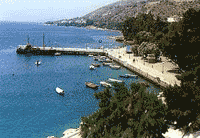 Loutraki is a well known spa, a therapeutic station and a tourist summer resort in the inner fold of the Bay of Corinth, famous for its therapeutic waters and climatic conditions rarely found elsewhere. It is an ideal place to visit with infinite potential for both winter and summer tourism.
Loutraki is a well known spa, a therapeutic station and a tourist summer resort in the inner fold of the Bay of Corinth, famous for its therapeutic waters and climatic conditions rarely found elsewhere. It is an ideal place to visit with infinite potential for both winter and summer tourism.
Loutraki has good road and rail connections with Athens, some 80Km away. Athens airport lies 85Km from Loutraki. It is the ideal solution for those of you who want to combine natural beauty and entertainment be it on your holidays or for a weekend.
Loutraki is connected to Athens via Athens-Corinth national road, to Patra and the Western Peloponnese via the Corinth-Patra national road and to Tripolis and the Southern Peloponnese via the Corinth-Tripolis national road.
Transportation needs of the municipality are satisfied by the Hellenic Bus Organization for road transportation, by the Hellenic Railway Organization for railway transportation, while its port is appropriate for yachts. At the same time, municipal buses are available for if you need to move around the city offering free services and frequent itineraries.
The Loutraki-Perahora Municipality was established in 1934, with its administrative centre in Loutraki. With a permanent population of 14,084 people, during summer the population grows to more than 100,000. Most people in Loutraki are involved in tourism, while agriculture, industry and handicraft are being developed.
The Loutraki Municipality is one of the most developed tourist areas in Greece. Loutraki has been a famous city since antiquity, mainly due to its therapeutic water springs. It takes its name from the ancient city of Thermes that was given by the goddess Diana Thermia, protectress of therapeutic water.
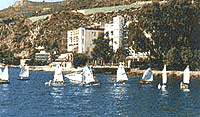 HISTORY: An enchanted journey through 2,500 years of history. Loutraki and the surrounding area is living proof that classical Greek values and antiquities still have much to teach us. All it takes is the desire to explore, and eyes and mind wide open to visit these antiquities, to admire them, to learn from them.
HISTORY: An enchanted journey through 2,500 years of history. Loutraki and the surrounding area is living proof that classical Greek values and antiquities still have much to teach us. All it takes is the desire to explore, and eyes and mind wide open to visit these antiquities, to admire them, to learn from them.
Apollo, god of the sun and well-being and Hera, mother of all the Gods, were worshipped here in temples whose ruins can still be seen today. The first written reference to the waters at Loutraki is in the «Hellenica» by the Athenian historian Xenophon (431-351 B.C.). He referred to Thermes (the ancient name of Loutraki) mentioning that Agisilaos, King of Sparta, had camped there during the Corinthian war (395-387 B.C.). His description combined with historical facts and archaeological finds undoubtedly confirm that this information refers to the city of Loutraki. The area also known as Peraea, in other words beyond Corinth (from the Greek pera for beyond) was colonized by the Corinthians in 750 BC.
There are also historical references that around 146 BC when the city passed into the control of the Romans, that General Sulla, was cured in its spa waters and thus its secrets were disseminated throughout the entire Roman world.
Moreover, plenty of churches built during the Byzantine era also point to the importance of the city and its historical development throughout ages. Loutraki played a significant role during the Greek Revolution in 1821 due to its geographical position as many battles took place there. The most famous one was against Dramalis (September 25-27, 1822) where Greek troops obliterated Dramalis’ forces – a victorious battle aided the outcome of the revolution greatly: the liberation and the establishment of the Greek State.
Nowadays, the international medical community is showing a great deal of interest in Loutraki due to its waters which are considered as equals to the famous waters of Vichi, Evian and Perrier.
Twelve kilometers outside the cosmopolitan Loutraki is lied the historical village of Perahora, well known for its wine production. In antiquity, it was called “Peraea” and there are a lot of archaeological finds – the ruins of ancient Oenoe (Schinos) and the tombs of Peraea – that confirm its existence since the prehistoric era. Though, the most important finds are located in the Heraion. There are ancient sites and the temple of the goddess Hera. Magnificent finds were also brought in light in this area such as ruins of temples, samples of ceramic art, silver and golden coins, copper tools, plenty of seals as well as road traces, fountains and tanks that indicate the existence of a well developed water collective system.
Finally, Isthmia is a famous city since antiquity due to the organization of the Panellenic games, so called “Isthmian Games”.
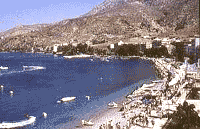 Infrastructure and Prospects: Tourist infrastructure of Loutraki is well developed, as Loutraki is a summer resort city and a theraupetical center providing a wide range of services for pleasant and comfortable stay. There are 55 hotel units – in all categories- ready to welcome tourists and visitors throughout year, while restaurants and taverns provide a great variety of traditional dishes and fresh fish.
Infrastructure and Prospects: Tourist infrastructure of Loutraki is well developed, as Loutraki is a summer resort city and a theraupetical center providing a wide range of services for pleasant and comfortable stay. There are 55 hotel units – in all categories- ready to welcome tourists and visitors throughout year, while restaurants and taverns provide a great variety of traditional dishes and fresh fish.
Loutraki is considered as the paradise of tourists, as it is an ideal place for swimming, fishing and sea sports. At the same time tennis courts, basket ball, volley ball and foot ball facilities are available for sport activities. Moreover, a wide range of shops, cinemas, bars and night clubs offer unlimited opportunities for shopping and entertainment.
Loutraki’s Casino that is the biggest in Europe with excellent services was established in 1995. A lot of investments have been scheduled, regarding further tourist development and infrastructure of the Municipality, including:
The inauguration of a new hotel aside Casino (capacity: 500 beds) in the short run;
A new yacht marina, 1500 m from the Casino (capacity: 700 yachts);
The construction of a Conference Centre;
The construction of a contemporary high quality unit of pools for curative bath; an area of 3.660 sq.m. planned to be one of the best full services centers of hydrotherapy in Europe;
The completion of the centre for canoe kayak races (4 Panellenic championships have already taken place);
The construction of training facilities in the framework of the organization of the Olympic Games 2004 in Athens;
The extension of the coastal road, of the port, etc.
 Loutraki is a well known spa, a therapeutic station and a tourist summer resort in the inner fold of the Bay of Corinth, famous for its therapeutic waters and climatic conditions rarely found elsewhere. It is an ideal place to visit with infinite potential for both winter and summer tourism.
Loutraki is a well known spa, a therapeutic station and a tourist summer resort in the inner fold of the Bay of Corinth, famous for its therapeutic waters and climatic conditions rarely found elsewhere. It is an ideal place to visit with infinite potential for both winter and summer tourism.Loutraki has good road and rail connections with Athens, some 80Km away. Athens airport lies 85Km from Loutraki. It is the ideal solution for those of you who want to combine natural beauty and entertainment be it on your holidays or for a weekend.
Loutraki is connected to Athens via Athens-Corinth national road, to Patra and the Western Peloponnese via the Corinth-Patra national road and to Tripolis and the Southern Peloponnese via the Corinth-Tripolis national road.
Transportation needs of the municipality are satisfied by the Hellenic Bus Organization for road transportation, by the Hellenic Railway Organization for railway transportation, while its port is appropriate for yachts. At the same time, municipal buses are available for if you need to move around the city offering free services and frequent itineraries.
The Loutraki-Perahora Municipality was established in 1934, with its administrative centre in Loutraki. With a permanent population of 14,084 people, during summer the population grows to more than 100,000. Most people in Loutraki are involved in tourism, while agriculture, industry and handicraft are being developed.
The Loutraki Municipality is one of the most developed tourist areas in Greece. Loutraki has been a famous city since antiquity, mainly due to its therapeutic water springs. It takes its name from the ancient city of Thermes that was given by the goddess Diana Thermia, protectress of therapeutic water.
 HISTORY: An enchanted journey through 2,500 years of history. Loutraki and the surrounding area is living proof that classical Greek values and antiquities still have much to teach us. All it takes is the desire to explore, and eyes and mind wide open to visit these antiquities, to admire them, to learn from them.
HISTORY: An enchanted journey through 2,500 years of history. Loutraki and the surrounding area is living proof that classical Greek values and antiquities still have much to teach us. All it takes is the desire to explore, and eyes and mind wide open to visit these antiquities, to admire them, to learn from them. Apollo, god of the sun and well-being and Hera, mother of all the Gods, were worshipped here in temples whose ruins can still be seen today. The first written reference to the waters at Loutraki is in the «Hellenica» by the Athenian historian Xenophon (431-351 B.C.). He referred to Thermes (the ancient name of Loutraki) mentioning that Agisilaos, King of Sparta, had camped there during the Corinthian war (395-387 B.C.). His description combined with historical facts and archaeological finds undoubtedly confirm that this information refers to the city of Loutraki. The area also known as Peraea, in other words beyond Corinth (from the Greek pera for beyond) was colonized by the Corinthians in 750 BC.
There are also historical references that around 146 BC when the city passed into the control of the Romans, that General Sulla, was cured in its spa waters and thus its secrets were disseminated throughout the entire Roman world.
Moreover, plenty of churches built during the Byzantine era also point to the importance of the city and its historical development throughout ages. Loutraki played a significant role during the Greek Revolution in 1821 due to its geographical position as many battles took place there. The most famous one was against Dramalis (September 25-27, 1822) where Greek troops obliterated Dramalis’ forces – a victorious battle aided the outcome of the revolution greatly: the liberation and the establishment of the Greek State.
Nowadays, the international medical community is showing a great deal of interest in Loutraki due to its waters which are considered as equals to the famous waters of Vichi, Evian and Perrier.
Twelve kilometers outside the cosmopolitan Loutraki is lied the historical village of Perahora, well known for its wine production. In antiquity, it was called “Peraea” and there are a lot of archaeological finds – the ruins of ancient Oenoe (Schinos) and the tombs of Peraea – that confirm its existence since the prehistoric era. Though, the most important finds are located in the Heraion. There are ancient sites and the temple of the goddess Hera. Magnificent finds were also brought in light in this area such as ruins of temples, samples of ceramic art, silver and golden coins, copper tools, plenty of seals as well as road traces, fountains and tanks that indicate the existence of a well developed water collective system.
Finally, Isthmia is a famous city since antiquity due to the organization of the Panellenic games, so called “Isthmian Games”.
 Infrastructure and Prospects: Tourist infrastructure of Loutraki is well developed, as Loutraki is a summer resort city and a theraupetical center providing a wide range of services for pleasant and comfortable stay. There are 55 hotel units – in all categories- ready to welcome tourists and visitors throughout year, while restaurants and taverns provide a great variety of traditional dishes and fresh fish.
Infrastructure and Prospects: Tourist infrastructure of Loutraki is well developed, as Loutraki is a summer resort city and a theraupetical center providing a wide range of services for pleasant and comfortable stay. There are 55 hotel units – in all categories- ready to welcome tourists and visitors throughout year, while restaurants and taverns provide a great variety of traditional dishes and fresh fish.Loutraki is considered as the paradise of tourists, as it is an ideal place for swimming, fishing and sea sports. At the same time tennis courts, basket ball, volley ball and foot ball facilities are available for sport activities. Moreover, a wide range of shops, cinemas, bars and night clubs offer unlimited opportunities for shopping and entertainment.
Loutraki’s Casino that is the biggest in Europe with excellent services was established in 1995. A lot of investments have been scheduled, regarding further tourist development and infrastructure of the Municipality, including:
The inauguration of a new hotel aside Casino (capacity: 500 beds) in the short run;
A new yacht marina, 1500 m from the Casino (capacity: 700 yachts);
The construction of a Conference Centre;
The construction of a contemporary high quality unit of pools for curative bath; an area of 3.660 sq.m. planned to be one of the best full services centers of hydrotherapy in Europe;
The completion of the centre for canoe kayak races (4 Panellenic championships have already taken place);
The construction of training facilities in the framework of the organization of the Olympic Games 2004 in Athens;
The extension of the coastal road, of the port, etc.

